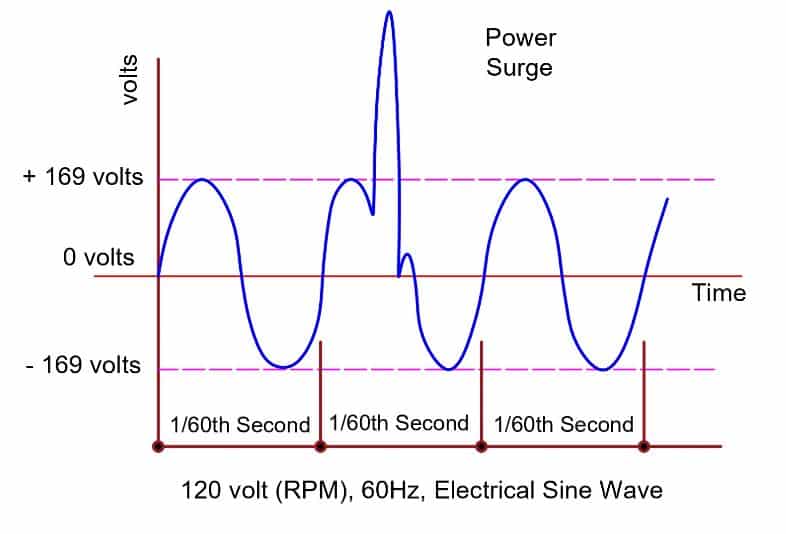We can define voltage surge as the sudden increase in voltage above the rated supply voltage. It is desirable that the electrical equipment must receive the supply voltage as per the equipment’s rated supply for reliable operation. Thus, we can say the voltage surges are the power quality problems.

Voltage surges cause a rise in line and phase voltage with respect to the ground. The voltage surges may cause damage to electrical equipment.
We can mainly classify the voltage surges into two categories.
- Internal Overvoltage
- External Overvoltage
Internal Overvoltage
The internal voltage that rises above the rated voltage within the electrical network is called internal overvoltage. The nature of internal voltage may be transient, dynamic, or stationary depending on the nature of the fault caused in the electrical network. The internal overvoltage may persist for a few cycles.
Stationary Overvoltage
When one of the healthy phases touches to ground, the two healthy phases supply the earth fault current. The fault current charges the capacitor formed between the phase and ground. This causes an increase in the voltage of healthy phases. The overvoltage caused by this reason may remain for a longer time. That is why this overvoltage is stationary in nature. The stationary overvoltage also occurs when we connect the neutral to the ground through the arc suppression coil. Thus, this phenomenon causes overvoltage in the healthy phase.
Dynamic Overvoltage
The generator supplies the power to electrical loads. The generator sets its power angle according to the load demand. What happens if a large part of the load is suddenly cut off? It will cause overvoltage at the normal frequency in the system. The overvoltage may adversely affect the transmission line, cable, and electrical network. The overvoltage caused by this reason is the dynamic overvoltage. This type of overvoltage remains for a few cycles because of its dynamic nature.
Transient Overvoltage
Transient overvoltage occurs when we switch on/off the inductive and capacitive load. Also, the transient overvoltage can reach tens of kilovolts with a duration of the order of microseconds. The transient overvoltage has high energy content, and therefore, it can cause damage to equipment connected to the line. The transient voltage also generates if a live phase suddenly touches the ground.
The magnitude of the internal overvoltage may reach four to five times the normal phase to neutral voltage. The high voltage is very harmful to the insulation of the electrical equipment. Eventually, overvoltage may cause premature failure of the equipment.
Main Reasons of Internal Overvoltage
1. Switching Operations on Unloaded Line
When we charge the transmission line, the traveling wave reaches the end of the transmission line. The traveling wave does not change its sign at the endpoint. Therefore, the voltage at the end of the transmission line becomes twice the system voltage. These reflected traveling waves travel back to the supply end, thus giving rise to further reflections.
2. Sudden Opening of Loaded Line
If a line carrying load is suddenly opened, a transient voltage of value given by e = i Zs is set up, where i is the instantaneous value of the current at the instant of the opening of the line, and Zs is the natural or surge impedance of the line.
The transient surges of the line depend on the line current at the instant of opening & surge impedance. It does not depend on the voltage. Therefore, low voltage transmission systems & high voltage transmission systems have the same magnitude of overvoltage.
3. Insulation Failure
The failure of insulation between the line and the earth is very frequent compared to the other types of faults. On insulation breakdown, the potential at-fault suddenly falls from maximum to zero, and therefore a negative voltage wave of a very steep front generates the surge in both directions.
4. Arcing Grounds
Arcing grounds occur when an earth fault develops on a transmission line connected to an all-insulated system. The reasons like the puncture of an insulator on an overhead line, accidental contact with trees, or the breakdown of a weak spot in the insulation of an underground cable causing flashover. The flashover generates a voltage surge in the electrical network. The conductor discharges through the agency of a transient high-frequency oscillation.
5. Resonance
The resonance in the electricals network happens when the capacitive reactance cancels out the inductive reactance. In other words, the capacitive reactance is equal to the inductive reactance (XL = XC ). Under this condition, the circuit is purely resistive and, the power factor is unity.
In an electrical network. the capacitive reactance is generally so small that resonance can not occur at the fundamental frequency. However, if the generator EMF wave distorts due to any reason, it increases the harmonics that have a higher frequency. And, it may cause trouble at a higher frequency.
External Overvoltage
There are external reasons for overvoltage in an electrical network. The overvoltage caused by static discharge, lightning strokes & other atmospheric reasons is called external overvoltage. The external overvoltage causes stress on the insulation system and finally causes insulation failure. The energy intensity of external overvoltage is generally is more than the internal overvoltage energy. And, thus it can cause severe damage to an electrical network.
The energy intensity of the external overvoltage caused by lightning depends on the way the lightning strikes the line. It may directly strike to line, maybe through a branch or streamer, or by induction.
The intensity of lightning depends on how directly the line is struck, i.e., directly by the main discharge, directly by a branch or streamer, or by the induction due to a flash passing near to but not touching the line.
There are two types of electrical installations- electrically-exposed and electrically non-exposed. The electrically-exposed equipment is installed outdoor and is subjected to voltage surges of the atmospheric origin. The insulation level of electrically-exposed equipment is more than that electrically non-exposed equipment.
Read Next: